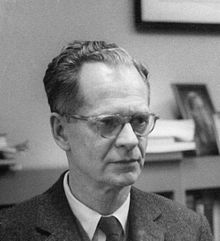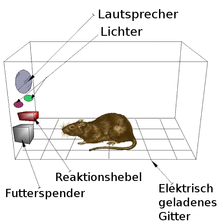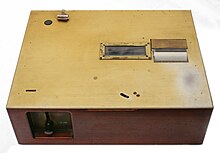BF Skinner

Burrhus Frederic Skinner (born March 20, 1904 in Susquehanna Depot , Susquehanna County , Pennsylvania , † August 18, 1990 in Cambridge , Massachusetts ), known as B. F. Skinner , was an American psychologist and the most prominent exponent of behaviorism in the United States . He coined the term operant conditioning , invented what is known as programmed learning and wrote the utopian novel Walden Two (initially published in German under the title Futurum Zwei ) , which received worldwide attention . Skinner is the founder of radical behaviorism and behavior analysis .
Skinner was named in 2002 in the Review of General Psychology (published by the American Psychological Association ) before Jean Piaget and Sigmund Freud as the most important psychologist of the 20th century.
life and work
After attending high school , Skinner completed an arts and linguistic degree at Hamilton College in Clinton , New York until 1926. He wanted to be a writer, but only put a dozen articles in newspapers, so he began working as an assistant in a bookstore in New York. According to the biography of his daughter Julie S. Vargas, he first became aware of the writings of Iwan Petrovich Pawlow and John B. Watson there and therefore enrolled at Harvard University in psychology from 1928 . At that time, a new behavioral physiology department had just been set up there, the head of which, William John Crozier , was trying to analyze animals “as a whole”, that is, without considering the processes inside them. Skinner was encouraged to conduct his own experiments and ultimately developed the apparatus named after him, with the help of which the behavior of test animals is in principle still quantified today - many German universities and schools also use such apparatus in the context of internships. Skinner's experimental approach became the basis of Experimental Behavioral Analysis . In 1949 Skinner was elected to the American Philosophical Society , 1950 to the National Academy of Sciences, and 1952 to the American Academy of Arts and Sciences .
The Skinner Box
Such a learning experiment can have the following sequence: An animal is placed in a special test cage into which at least one small lever protrudes (today such a test apparatus is called a “ Skinner box ”); every lever pressure of the test animal is translated into the upward movement of a pen under which a strip of paper is moved horizontally to the side. This creates a cumulative recording (the recording device is called the Cumulative Recorder ), in which the reaction of the animal is documented depending on the duration of the learning test - the steeper the curve, the faster the animal has learned the action desired by the test leader. Such an action can, for example, look like this: The test animal presses the lever after a lamp lights up or after an acoustic signal.
Learning based on reward
In his experiments, Skinner discovered that the frequency of lever pressures in his rats was not only dependent on previous stimuli (as Watson and Pavlov had emphasized), but also - and above all - on stimuli that only followed after the lever was pressed: so he investigated no behaviors that (like the reflexes) proceed according to the relatively rigid principle of “stimulus - reaction”, but were influenced by environmental influences (i.e. the consequences following a reaction) - for example by a food reward. Skinner coined the term "operant behavior" for the movement sequences built up in this way in the test animal. The process in the course of which the operant behavior is generated, he called "operant conditioning "; the word “learn” is forbidden here, since it is an assumed mental process in the animal, which is viewed as unscientific in the context of Skinner's learning theory.
Pigeons in military service
Due to his successful behavioral biology work, after completing his doctorate in 1931 at Harvard, he was able to research independently for five years, but in 1936 he switched to teaching (and later professor) psychology at the University of Minnesota in Minneapolis, where he no longer continued his experimental studies. It was not until 1944, when Germany was already using remote-controlled bombs against targets in England during World War II ( V2 rockets that could still be guided in flight), that Skinner reactivated his willingness to experiment: He went looking for financial support for a (nowadays grotesque) top secret military project. Skinner trained pigeons whose picking movements were to be used to keep a long-range missile on course; Apparently he planned to add a pigeon to every rocket - but then they decided to use radar-based remote control systems. Nevertheless, pigeons remained the most important model organisms for Skinner's behavioral studies in later years; in any case, he never again carried out experiments with rats.
There are film recordings of conditioned pigeons that can be used, for example, to understand the emergence of superstitious behavior.
Living in a planned society
In 1948 Skinner returned to Harvard as a full professor of psychology and stayed at that university until his retirement in 1974. Also in 1948, under the impression of hundreds of thousands of war returnees, he wrote his novel Walden Two (the first German edition was titled: Futurum Zwei ) however, it only became a much discussed book after more than a decade. The novel depicts the life of a community formed by operant conditioning and continues to attract international attention to this day. In it Skinner shows a peaceful coexistence in a conflict-free society, which is based on technologies of behavior control and in particular on the positive reinforcement of socially desired behavior. This utopian novel became Skinner's best-known work, but because of the social and behavioral techniques propagated in it, which many assessed as manipulative, it is widely received - against Skinner's intention - as a "negative utopia": The novel (and Skinner himself) leaves the question open who should have the right (omnipotence) to determine the social framework conditions that determine the coexistence of the members of this society down to the last detail, including their ethical norms.
Skinner received criticism in the 1940s when he propagated a storage box for toddlers called Air Crib ("airy cot") and temporarily kept his own daughter in it. However, his daughter denied in 2004 that this accommodation was comparable to a Skinner box. The Air Crib was used and distributed by her father with the intention of making life easier for young parents. This housing method has adherents to this day.
Programmed learning and language laboratories, language as behavior
Science and Human Behavior appeared in 1953 , in which Skinner transferred the knowledge gained from animal models to humans. In the further course of the 1950s, Skinner developed so-called learning machines and the method of programmed learning on the basis of the learning-theoretical considerations already described in Walden Two , which is based on breaking down the entire learning material into small sub-units, the correct reproduction of which is "rewarded" by permission to undertake the next learning step, so that you can gradually acquire knowledge yourself in self-study and also control the learning success yourself. This approach was quite popular among young teachers in Germany in the 1960s, but was largely forgotten and only celebrated a certain comeback with the “modern” PC-based language learning programs. The so-called language laboratories also owe their existence to Skinner.
In 1957 Skinner completed over 20 years of work on Verbal Behavior , his theory of linguistic behavior. Skinner interpreted human language as behavior subject to the same laws as all other behavior. Skinner himself considered verbal behavior to be his major work. Verbal behavior also marks the beginning of the so-called cognitive turn . In the years and decades that followed, many psychologists turned away from behaviorism in general, and Skinner's behavioral analysis in particular, and turned to cognitive psychology . It is worth mentioning in this context the linguist Noam Chomsky's review of the book . Chomsky's criticism received widespread attention and is still sometimes viewed as a refutation of Skinner's positions.
Late years
In his later years, Skinner was very pessimistic about people's ability to avert future threats of global proportions such as environmental degradation , resource scarcity and overpopulation . In an essay he provided a psychological explanation for the lack of effective preventive measures despite existing technical and scientific knowledge.
Skinner, whose main work Science and Human Behavior (German: Wissenschaft und Menschliches Behavior ) was published in 1953, wrote books and essays into old age, even after he was diagnosed with leukemia in 1989. Ten days before his death, he gave his last talk to the American Psychological Association . His daughter noted: “He finished the article from which the talk was taken on August 18, 1990, the day he died.” (“He finished the article from which the talk was taken on August 18, 1990, the day he died. ")
Operant Conditioning: A Brief Overview
Skinner continued the fundamental work of Edward Lee Thorndike and coined the term operant conditioning to differentiate it from classical conditioning .
The classical conditioning, which was first researched by Ivan Petrovich Pavlov , uses the existence of an already existing sequence of stimuli and reactions (even smelling food causes salivation to begin). The experimenter then always offers a different type of stimulus (for example a bell tone) parallel to the usual stimulus, with the result that after successful conditioning, salivation begins as soon as the bell rings.
In contrast to classical conditioning, in operant conditioning, spontaneous behavior is promoted or reduced by the following consequence . The most effective effects have also been shown in animal experiments, i.e. a reward, for example with food. However, avoidance reactions can also be conditioned, in cats and other pets, for example with the help of punishment by water splashes.
While classical conditioning is always based on an already largely existing repertoire of behavior and this basically only varies, with the help of operant conditioning very diverse new behavioral patterns can be generated (although here too, of course, the basic movement sequences must, at least as physiologically possible, already exist beforehand). Training horses and successfully completing a "dog school" has long been based entirely on the behavioral shaping techniques that Skinner has systematically researched.
The two variants of conditioning can be described as follows:
- S ⇒ R ( S timulus - R esponse; stimulus - response)
- S ⇒ R ⇒ C (in addition: C onsequence; consequence), where “C” has a retroactive effect on “R”: either positive or negative (either the probability of occurrence of the SRC sequence will increase thanks to a reward or due to a punishment Reduce)
Works
- A case history in scientific method. In: American Psychologist. 11, 1956, pp. 221-33 (contains a description of his scientific beginnings with the "Skinner box").
- The Behavior of Organisms: An Experimental Analysis . 1938. (contains a review of his early studies at Harvard) (reprinted 1991 and 1999 by the BF Skinner Foundation, ISBN 0-87411-487-X ). Full text (PDF)
- Verbal Behavior . 1957. (reprinted by the BF Skinner Foundation, ISBN 0-87411-591-4 , archive.org )
- The Technology of Teaching . 1968, ISBN 0-13-902163-9 . (contains a summary of his writings on "programmed learning") (reprinted in 2003 by the BF Skinner Foundation; Library of Congress Card Number 68-12340 E 81290)
-
Walden Two. An utopian novel . Utopian narrative. Macmillan Verlag, New York 1948. (New edition 1969 with the current essay by the author: Walden Two Revisited )
- Future two. The vision of a non-aggressive society . Wegner-Verlag , Hamburg 1970. (Rowohlt-Verlag, Reinbek 1972.)
- Walden Two. The vision of a better form of society . New translation by Harry T. Master. Fi-Fa-Verlag, Munich 2002.
- Science and human behavior. Science and Human Behavior (downloadable PDF file). Kindler, Munich 1973, ISBN 3-463-00562-X .
- The function of reinforcement in behavioral science . Kindler, Munich 1974, ISBN 3-463-00587-5 .
- Beyond freedom and dignity . (German version of Beyond Freedom and Dignity .) Rowohlt, Reinbek 1982, ISBN 3-498-06101-1 .
- What is behaviorism? (German version of About Behaviorism .) Rowohlt, Reinbek 1982, ISBN 3-498-06124-0 .
literature
- Daniel W. Bjork: BF Skinner: A Life . American Psychological Association, Harvard 1997, ISBN 1-55798-416-6 .
- John Clute : Skinner, B F. In: John Clute, Peter Nicholls : The Encyclopedia of Science Fiction . 3. Edition. (Online edition), version dated August 12, 2018.
- Geir Overskeid, Cato Grønnerød, Dean Keith Simonton: The Personality of a Nonperson Gauging the Inner Skinner. In: Perspectives on Psychological Science. Volume 7, No. 2, 2012, pp. 187-197, doi: 10.1177 / 1745691611434212
- Burrhus F. Skinner , in: Internationales Biographisches Archiv 44/1990 of October 22, 1990, in the Munzinger Archive ( beginning of article freely available)
- BF Skinner's Walden II , in: Rudolf H. Moos , Robert Brownstein: Environment and Utopia: a synthesis . New York: Plenum Press, 1977 ISBN 0-306-30985-8 , pp. 163-195
See also
Web links
- Literature by and about BF Skinner in the catalog of the German National Library
- BF Skinner Foundation (English)
- BF Skinner in the Internet Speculative Fiction Database (English)
Individual evidence
-
↑ , Steven J. Haggbloom et al: The 100 most eminent psychologists of the 20th century. In: Review of General Psychology. Volume 6, No. 2, 2002, pp. 139–152, doi: 10.1037 / 1089-2680.6.2.139
The 100 most important psychologists of the 20th century , excerpt from: Monitor on Psychology , July / August 2002, pp. 28–29 . - ^ Member History: BF Skinner. American Philosophical Society, accessed December 3, 2018 .
- ↑ See: Burrhus Frederic Skinner: Superstition in the Pigeon. In: Journal of Experimental Psychology. Volume 38, 1947, pp. 168–172, (full text)
- ↑ Gentle compulsion. American psychologist Skinner claims that freedom and human dignity are an illusion. In: Der Spiegel . No. 40, 1971, pp. 171-172.
- ↑ Deborah Skinner Buzan: "I was not a lab rat." In: The Guardian . March 12, 2004.
- ↑ Nick Joyce, Cathy Faye: Skinner Air Crib. In: The Observer . September 2010 (with a picture of Air Crib )
- ^ "My reason for discussing Skinner's book in such detail was that it was the most careful and thoroughgoing presentation of such speculations, an evaluation that I feel is still accurate. Therefore, if the conclusions I attempted to substantiate in the review are correct, as I believe they are, then Skinner's work can be regarded as, in effect, a reductio ad absurdum of behaviorist assumptions. “Noam Chomsky: A Review of BF Skinner's Verbal Behavior. In: Leon A. Jakobovits, Murray S. Miron (Eds.): Readings in the Psychology of Language. Prentice-Hall, 1967, pp. 142-143; Full text at chomsky.info
- ^ Joel Greenberg: BF Skinner now sees little Hope for the World's Salvation . In: New York Times . September 15, 1981.
- ↑ R. Rumph, C. Ninness, G. McCuller, SK Ninness: Guest editorial: Twenty years later, commentary on Skinner's, Why We Are Not Acting to Save the World '. In: Behavior and Social Issues. Volume 14, No. 1 2005, pp. 1-6.
- ↑ Why we are not acting to save the world. In: BF Skinner: Upon further reflection. Prentice-Hall, Englewood Cliffs, NJ 1987, pp. 1-14.
- ↑ Skinner 1948 (Walden Two) - Foreword by the author 1969 and by Prof. Werner Correll on the German first edition, trans. M. Schwarzbach
| personal data | |
|---|---|
| SURNAME | Skinner, BF |
| ALTERNATIVE NAMES | Skinner, Burrhus Frederic (full name) |
| BRIEF DESCRIPTION | American representative of behaviorism, coined the term "operant conditioning" |
| DATE OF BIRTH | March 20, 1904 |
| PLACE OF BIRTH | Susquehanna Depot , Pennsylvania |
| DATE OF DEATH | August 18, 1990 |
| Place of death | Cambridge , Massachusetts |


